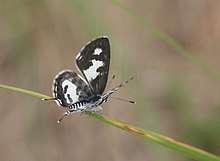Tuxentius calice
Tuxentius calice, the white pie, is a butterfly of the family Lycaenidae. It is found in Africa southwards of the equator.
| White pie | |
|---|---|
 | |
 | |
| T. c. calice in South Africa | |
| Scientific classification | |
| Kingdom: | Animalia |
| Phylum: | Arthropoda |
| Class: | Insecta |
| Order: | Lepidoptera |
| Family: | Lycaenidae |
| Genus: | Tuxentius |
| Species: | T. calice |
| Binomial name | |
| Tuxentius calice | |
| Synonyms | |
| |
The wingspan is 21–24 mm for males and 21–25 mm for females. Adults are on wing year-round, but are most common from October to March.[2]
The larvae feed on Ziziphus mucronata and probably other Ziziphus species.
Subspecies
- Tuxentius calice calice — South Africa, Zimbabwe, Mozambique, Botswana, Zambia, southern Zaire (Shaba), Angola, Malawi, southern Tanzania
- Tuxentius calice gregorii (Butler, 1894) — northern Tanzania, central Kenya
gollark: Hey, that actually could pay for osmarks.tk expenses, assuming no conversion losses whatsoever.
gollark: ... citizenship?
gollark: No it's not, it's two syllables vs one.
gollark: So why is "hodl" a better descriptor than just... "hold"?
gollark: Ah yes, of course.
References
| Wikimedia Commons has media related to Tuxentius calice. |
| Wikispecies has information related to Tuxentius calice |
- Tuxentius at Markku Savela's Lepidoptera and Some Other Life Forms
- Woodhall, Steve (2005). Field Guide to Butterflies of South Africa. Cape Town, South Africa: Struik. ISBN 978-1-86872-724-7.
This article is issued from Wikipedia. The text is licensed under Creative Commons - Attribution - Sharealike. Additional terms may apply for the media files.